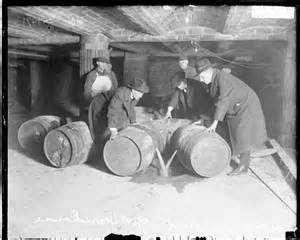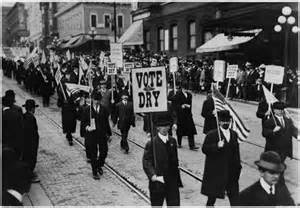The 18th Amendment
The 18th Amendment exists as a number of precedents. It was the first Amendment to set a time limit for its ratification and for its implementation. And, it is the only Amendment no longer the letter of the law, since it was repealed by the 21st Amendment.
Efforts to make alcoholic beverages illegal began early in the history of the United States and came to be known as the temperance movement. Religious in nature, the temperance movement had a large number of women, who were also concerned with domestic violence, which they saw as the direct result of alcohol abuse. It wasn't just women in the temperance movement, though, as men campaigned to ban alcohol as well. Statewide prohibition efforts became popular, beginning in the early part of the 19th Century. One of the first national temperance organizations was the American Temperance Society (ATS), formed in 1826. Within a decade, the ATS had 1.5 million members. Maine passed a statewide prohibition law in the mid-19th Century but repealed it a few years later. Such laws were being discussed in other states as well. In 1873, one of the larger organizations, the Women's Christian Temperance Union (WCTU), issued a call for a ban on the sale of alcohol, a plea echoed by the Anti-Saloon League (ASL) several years later. Members of these organizations and people sympathetic to their cause, men and women, demonstrated publicly against the sale of alcohol. Demonstrations took place where alcohol was sold, at saloons and bars, and at public rallies. The Kansas State Constitution outlawed alcohol in 1881. The temperance movement was largely nonviolent, although one particularly famous leader, Carrie Nation, made a name for herself by using a hatchet to break saloon mirrors and windows and to split open kegs of beer or whiskey. Arrested several times, she became famous for her temperance tactics. B With the approval of the 36th state, Nebraska, on January 16, 1919, the 18th Amendment was the law of the land. As stipulated by its own language, the Amendment took effect 366 days later. In the meantime, Congress had approved the Volstead Act, including a vote by both houses to override a veto by President Woodrow Wilson. The 18th Amendment Section 1. After one year from the ratification of this article the manufacture, sale, or transportation of intoxicating liquors within, the importation thereof into, or the exportation thereof from the United States and all territory subject to the jurisdiction thereof for beverage purposes is hereby prohibited. Section 2. The Congress and the several States shall have concurrent power to enforce this article by appropriate legislation. Section 3. This article shall be inoperative unless it shall have been ratified as an amendment to the Constitution by the legislatures of the several States, as provided in the Constitution, within seven years from the date of the submission hereof to the States by the Congress. |
|
Social Studies for Kids
copyright 2002–2024
David White



 Along with the related
Along with the related  y 1916, half of the states had prohibition laws on their books, but those laws didn't ban the consumption of alcohol in the home. The 18th Amendment didn't, either, nor did the Volstead Act (officially the National Prohibition Act, named after its sponsor, Andrew Volstead of Minnesota) ban the consumption of alcohol for medicinal or sacramental purposes.
y 1916, half of the states had prohibition laws on their books, but those laws didn't ban the consumption of alcohol in the home. The 18th Amendment didn't, either, nor did the Volstead Act (officially the National Prohibition Act, named after its sponsor, Andrew Volstead of Minnesota) ban the consumption of alcohol for medicinal or sacramental purposes.
